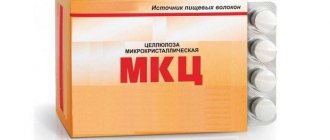Listata
Pharmacodynamics
Orlistat is a potent, specific and reversible inhibitor of gastrointestinal lipases with a long-lasting effect. Its therapeutic effect occurs in the lumen of the stomach and small intestine and consists of the formation of a covalent bond with the active serine site of gastric and pancreatic lipases.
The inactivated enzyme then loses the ability to break down food fats, which come in the form of triglycerides, into absorbable free fatty acids and monoglycerides. Since unsplit triglycerides are not absorbed, the resulting decrease in caloric intake into the body leads to a decrease in body weight. Thus, the therapeutic effect of the drug is carried out without absorption into the systemic circulation.
Based on fecal fat results, the effects of orlistat begin 24 to 48 hours after dosing. After discontinuation of orlistat, fecal fat content usually returns to pre-therapy levels within 48-72 hours.
Clinical effectiveness
Patients taking orlistat experience greater weight loss compared to patients on diet therapy. Body weight loss begins within the first 2 weeks after the start of treatment and continues from 6 to 12 months, even in patients with a negative response to diet therapy. Over the course of 2 years, there was a statistically significant improvement in the profile of metabolic risk factors associated with obesity. In addition, compared to placebo, there was a significant reduction in body fat. Orlistat is effective in preventing weight gain. Re-gain of body weight, no more than 25% of lost, is observed in approximately half of the patients, and in half of these patients, re-gain of body weight is not observed or even a further decrease is observed.
Overweight or obese patients with type 2 diabetes mellitus treated with orlistat for 6 months to 1 year experienced greater weight loss compared with patients receiving dietary therapy alone. Weight loss occurs mainly due to a decrease in the amount of fat in the body. With orlistat therapy, a statistically and clinically significant improvement in glycemic control is observed. In addition, during therapy with orlistat, there is a decrease in the dose of hypoglycemic agents, insulin concentration, as well as a decrease in insulin resistance.
When using orlistat for 4 years, the risk of developing type 2 diabetes mellitus is significantly reduced (by approximately 37% compared to placebo). The degree of risk reduction is even greater in patients with baseline impaired glucose tolerance (approximately 45%).
Maintaining body weight at a new level is observed throughout the entire period of use of the drug.
When orlistat was used for 1 year in obese adolescents, there was a decrease in BMI, a decrease in fat mass, and a decrease in waist and hip circumference compared to the placebo group. Also, patients treated with orlistat showed a significant decrease in diastolic blood pressure compared to the placebo group.
Pharmacokinetics
Suction
In normal weight and obese volunteers, systemic exposure to orlistat is minimal. After a single oral dose of 360 mg, unchanged orlistat is undetectable in plasma, which means that its concentrations are below the limit of quantitation (less than 5 ng/ml).
In general, after taking therapeutic doses, it was possible to detect unchanged orlistat in blood plasma only in rare cases, and its concentrations were extremely low (less than 10 ng/ml or 0.02 μmol). There are no signs of accumulation, which confirms that the absorption of orlistat is minimal.
Distribution
Vd cannot be determined because orlistat is very poorly absorbed. In vitro, orlistat is more than 99% bound to plasma proteins (mainly lipoproteins and albumin). In minimal quantities, orlistat can penetrate red blood cells.
Metabolism
Orlistat is metabolized primarily in the intestinal wall. In obese patients, approximately 42% of the minimal fraction of orlistat that is absorbed systemically is accounted for by two main metabolites - M1 (a four-membered hydrolyzed lactone ring) and M3 (M1 with a cleaved N-formylleucine residue).
Molecules M1 and M3 have an open b-lactone ring and inhibit lipase extremely weakly (1000 and 2500 times weaker, respectively, than orlistat).
Given this low inhibitory activity and low plasma concentrations (average 26 ng/ml and 108 ng/ml, respectively) after therapeutic doses, these metabolites are considered pharmacologically inactive.
Removal
In individuals with normal and overweight, the main route of elimination is the elimination of unabsorbed orlistat through the intestines. About 97% of the dose taken is excreted through the intestines, with 83% as unchanged orlistat.
The cumulative renal excretion of all substances structurally related to orlistat is less than 2% of the administered dose. The time until orlistat is completely eliminated from the body (through the intestines and kidneys) is 3-5 days. The ratio of orlistat elimination routes in volunteers with normal and overweight was the same. Both orlistat and the metabolites M1 and M3 can be excreted in the bile.
Pharmacokinetics in special clinical groups
Plasma concentrations of orlistat and its metabolites (M1 and M3) in children do not differ from those in adults when comparing the same doses of orlistat. Daily excretion of fat in feces is 27% of dietary intake during orlistat therapy.
Release form and composition
The drug is produced in the form of film-coated tablets: blue, pearlescent, oval, biconvex, with the symbol “f” on one side and a line mark on the other; the core is almost white or white (10 pcs each in blister packs, in a cardboard pack there are 1, 2, 3, 6 or 9 packs and instructions for use of Listata).
1 tablet contains:
- active ingredient: orlistat – 120 mg;
- auxiliary components: sodium lauryl sulfate, acacia gum, mannitol, copovidone, crospovidone, magnesium stearate;
- film shell: Opadry II blue (85F205040) (polyvinyl alcohol, macrogol 3350, titanium dioxide, aluminum blue varnish, yellow iron oxide dye, talc), Opadry silver (63F97546) (polyvinyl alcohol, polysorbate-80, macrogol 3350, pearlescent pigment, talc).
results
In the first month of taking the product, it is possible to get rid of 4 kg of excess weight, but swelling and excess fluid from the body go away. During the same period, the system of metabolic processes undergoes a restructuring, so better results can be expected only from the second month of use.
If you follow a low-calorie diet, your weight will decrease by 6 - 10 kg monthly, and if the person losing weight also engages in physical exercise, the process will go faster.
We recommend reading about Mangosteen syrup for weight loss. You will learn about the beneficial properties of mangosteen, the use of syrup, weight loss results, contraindications. And here is more information about the use of Siberian fiber for weight loss.
Listata tablets for weight loss are highly effective. They belong to medications and must be prescribed by a doctor, as there are contraindications to their use.
How to use a weight loss product
The drug should be taken according to a strict regimen: 1 tablet with meals or a maximum of an hour after the end of the meal. You cannot increase the amount, as this will lead to the development of side effects, but will not speed up the weight loss process. In addition, if the food is low-calorie and low-fat (for example, you consumed a vegetable salad and boiled white chicken meat), then you should skip taking Listata.
The duration of the course of taking a weight loss product is variable and can range from 6 months to 4 years.
It is also worth emphasizing that those who are losing weight will have to adjust their diet and not only reduce the total amount of foods consumed, but also choose only those that have a low fat content. When prescribing Listata, nutritionists recommend that their patients follow a low-calorie diet - the menu should be varied, but not more than 1300 kcal per day. If desired, it is quite possible to make food tasty without completely giving up sweets.
Morning
- 4 medium-sized carrots, raw + 1.5 tablespoons of low-fat sour cream;
- a cup of coffee with milk based on 1 teaspoon of sugar and a dry drink (instant) + 25 ml of low-fat milk.
After 2 - 3 hours, drink 1 glass (maximum 300 ml) of kefir with a fat content of no more than 2.5.
Day
- a medium-sized plate of chicken broth + 50 g of rye or bran bread;
- stewed or baked sea fish (for example, catfish) in the amount of 100 g;
- boiled, stewed or baked cauliflower with fish – 100 g.
For drinks, you are allowed to take water with lemon juice or green tea without sugar, but in any quantity.
After 2 - 3 hours, you are allowed to eat 1 piece of kiwi or a bunch of green grapes.
Evening
- boiled rice with beef – 100 g of each product;
- sweet pepper (preferably red) – 1 medium-sized piece;
- medium sized red tomato – 1 piece.
For drinks, you can choose a decoction of rose hips or hawthorn, black tea without sugar.
If you have a strong desire to eat sweets, then in the break between breakfast and lunch you can treat yourself to 50 g of dark chocolate or 100 g of any pastry.
With such a menu, 1035 kcal will enter the body per day, which, in combination with taking Listat tablets, will give an excellent effect.
Side effects
- from the digestive system: very often (more than 1/10) - discomfort or pain in the abdomen, flatulence, release of gases with some discharge, oily discharge from the rectum, steatorrhea, imperative urge to defecate, loose stools, increased frequency of bowel movements (these side effects reactions occur in the first 3 months of therapy, are mild and transient in nature, their frequency increases with increasing fat content in food); often (more than 1/100, but less than 1/10) - damage to teeth and/or gums, bloating, pain or discomfort in the rectum, soft stools, fecal incontinence; very rarely (less than 1/10,000) - increased activity of liver transaminases and alkaline phosphatase, hepatitis; frequency not established (available data do not allow us to establish the frequency of adverse events) - rectal bleeding, diverticulitis, cholelithiasis, pancreatitis;
- allergic reactions: rarely (more than 1/10,000, but less than 1/1000) – itching, skin rash, urticaria, bronchospasm, angioedema, anaphylaxis; very rarely - bullous rash;
- other: very often - upper respiratory tract infections, headache, flu; often - anxiety, weakness, urinary tract infections, lower respiratory tract infections, dysmenorrhea; frequency not established – oxalate nephropathy.
In addition, hypoglycemic conditions and abdominal bloating were frequently reported during post-marketing surveillance in patients with type 2 diabetes mellitus.
Useful video
Watch this video about new effective weight loss drugs:
Similar articles
- Siofor for weight loss (500, 850, 1000): how to take...
The drug Siofor for weight loss in general is not intended. It is prescribed for diabetics. However, the question is increasingly asked how to use it to lose weight. For example, it is worth choosing a dosage of 500 mg, rather than 850 or 1000. It also does not hurt to become familiar with the side effects. Read more - Saxenda and weight loss: how effective, what is better...
The drug "Saxenda" makes weight loss easy and safe. It allows you to lose up to 10% of body weight. It is injected into the stomach, thigh or arm with a special syringe pen. Saxenda or Victoza - which is better for weight loss? Read more
- Bioliposuctor of the abdomen: rules of use, real...
The drug Bioliposuctor for the abdomen is advertised on the Internet, but real reviews are contradictory. The rules of use are simple, there are side effects. Will it help for weight loss? Read more
Reviews from nutritionists
Despite the fact that the drug is a medicinal product, it should be taken by those who have pre-obesity or obesity of degrees 1, 2 and 3 or people with a body mass index of 28. Body mass index can be calculated as follows: weight in kilograms divided by the square of height in meters. The weight loss product should be taken strictly according to the instructions and drink 3 tablets a day to avoid overdose
In a month, with the help of Listata you can lose 10 kilograms. The drug inhibits the activity of lipases, thereby changing the digestion process. Therefore, the product can cause inconvenience - some people run to the toilet, others suffer from colic. It is worth noting that Listata performs an auxiliary function in normalizing weight. And the basis is proper nutrition. That is why those patients who go on diets and consume less fat do not notice the shortcomings of the drug. Also, don’t forget about physical activity.
The component of the drug is gum arabic. It allows you to better tolerate the weight loss product - it emulsifies fats, preventing them from collecting into large drops. This is why Listata mini wins over similar drugs
Drug interactions
- amitriptyline, atorvastatin, digoxin, fibrates, biguanides, fluoxetine, losartan, phenytoin, phentermine, pravastatin, nifedipine slow release, nifedipine GITS (gastrointestinal therapeutic system), sibutramine, oral contraceptives, ethanol: the combination of orlistat with any of these drugs does not cause drug interactions;
- indirect-acting anticoagulants (including warfarin): against the background of concomitant therapy with indirect-acting anticoagulants, a decrease in prothrombin, an increase in INR values (international normalized ratio), and changes in hemostatic parameters are possible;
- antiepileptic drugs: there is a risk of developing seizures in patients taking anticonvulsants;
- acarbose: it is recommended to avoid combination with Listata;
- beta-carotene, vitamins D and E: absorption of these vitamins is reduced with orlistat, so they should be taken before bed or 2 hours after taking the drug;
- cyclosporine: a decrease in its concentration in the blood plasma is possible;
- amiodarone (oral dosage form): a 25–30% decrease in the systemic exposure of amiodarone and desethylamiodarone is observed, and its clinical effect may be reduced.










